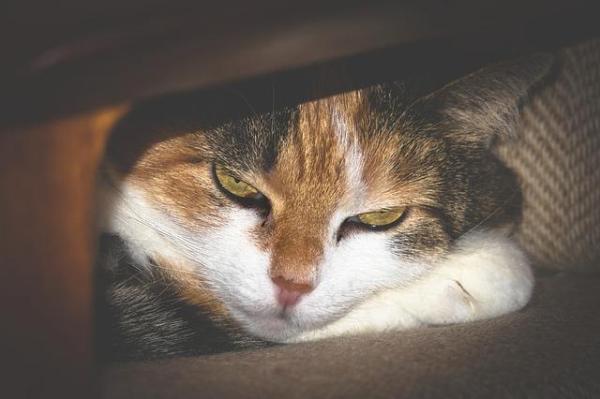Is My Cat Too Hot? - Cat Overheating Signs



See files for Cats
Depending on where you live, the approach of the hotter months can change your routine and make daily life difficult. If this happens to you, it is important to remember it will also happen to your cat. There are various effects the increased heat will have on a feline. Even seemingly small changes in temperature can reduce their activity levels, change where they go and cause behavioral changes. Hotter weather also provides possible health risks, specifically the risk of heat stroke and hyperthermia. To know if a cat is too hot, we need to look at specific signs of overheating in cats.
At AnimalWised, we as is my cat too hot? We look at cat overheating signs and what you can do to prevent this from happening if the temperatures rise.
Do cats feel the heat?
Cats and humans don't regulate themselves in the same way. When we are hot, it is noticeable by looking at our skin as we are more likely to sweat. Cats only have sweat glands on their paws and it is difficult to see visible secretion of sweat. This doesn't mean they don't feel the heat. In fact, since many wild cats are indigenous to cooler climates, the coat of their domestic relations are designed to keep heat in.
When summer rolls around, the cat will molt some of their coat to reduce the insulating effect of their coat. This will not change completely. They still have fur and they will continue to generate heat from their growth, metabolism and movement. These processes can make the summer months a little tricky for felines.
Cats groom themselves for many reasons, one of them is to regulate body temperature. The saliva they leave on their skin evaporates and helps to cool them down in summer. A cat becomes overheated when less heat is dissipated than produced. For this reason, when the ambient temperature is higher, a cat will become overheated.
Symptoms of overheating in cats
Domestic cats with guardians do not have the same need as wild cats to hunt food, but they will still be active. This activity reduces in the hotter months. Sometimes they can spend all day hidden in the coolest areas of the home, only to emerge once the temperature drops. Although cats usually love the sun's rays, hot weather will make them want to hide from them.
When a cat is too hot, they can develop various behavioral differences. Some of these are similar to when they have a pathological disease or other medical condition, so it is important we be aware of any changes in their daily routine.
Signs that a cat is overheated include:
- Increase in water consumption
- Weakness
- Inactivity
- Bluish or purplish tongue
- Hypersalivation
- Muscle tremors
- Excessive grooming
Cats will drink more water when overheated. This is to compensate for loss of moisture, improve hydration and refresh the body. You have to be careful with this symptom because it can also indicate the existence of pathologies such as diabetes or kidney disease. Dehydration in cats itself is very worrying and can be fatal in acute cases.
Hyperthermia in cats
When outside temperatures are very high and cats are not protected, they can suffer from hyperthermia. This is also known as heat stroke and occurs when their temperature is above 39.2 ºC, i.e. the highest body temperature that can be considered normal for cats. You can read in this article how to measure your cat's temperature if you have doubts. In these cases, the cat has a higher temperature ambient heat, not due to fever.
Elevated body temperature can result in various clinical signs in cats, such as:
- Excessive panting
- Altered breathing
- Tremors
- Seizures
- Difficulty maintaining posture
- Vomiting
- Reddish rashes on the skin
- Bluish skin and mucous membranes
When a cat's respiration is altered, it can often mean the cat's respiration rate high, even when the cat is at rest. This can result in the cat not receiving enough oxygen, something which can result in the pale mucus membranes of the cat's mouth, eyes or other parts of the body. These are very serious clinical signs and will requite veterinary medical intervention.

How hot is too hot for cats?
There is a temperature range in which cats can regulate their heat loss in a way which allows them to maintain a healthy body temperature. This is the ideal ambient temperature for cats. While not ideal in terms of comfort, the cat shouldn't develop any health problems if this is the case.
In general, the ideal temperature for a cat is when the ambient space is between 17 ºC/62 ºF to 30 ºC/86 ºF. If the temperature is hotter than this range, the cat will be too hot. Their behavior can be affected and their health threatened.
However, not all cats are the same. Some may be better or less able to tolerate heat than others. This is due to many factors. Cats suffering from obesity will get hot easier since they are insulated by additional body fat. Breed is also important since longhair cats may get hotter more quickly. Conversely, hairless cat breeds such as the Sphynx may tolerate heat a little better, although over 30 ºC/86 ºF is too hot for almost any cat.
Regardless of the breed, all cats will need to be protected from the sun. Hairless cats are more susceptible to skin cancers and will need more protection.

How to prevent a cat overheating
Given the negative consequences that excessive heat can have on the health of our cats, we must protect them. Doing so will help to prevent them from suffering from heat stroke. It will also make them better able to manage the heat and live in better comfort during the summer. Here are our health tips to prevent your cat getting too hot:
- Move them to a cool and well-ventilated place.
- If the cat already shows signs of heat, you can moisten their head, neck and back to cool them down and reduce their temperature. This can be done by moistening a face towel or flannel with cool water. Do not use ice as this can be much too cold for a cat.
- Avoid allowing them outside during the hottest hours or on days with extreme temperatures.
- Always keep their water bowl with fresh and clean water. Replenish the water frequently. A good idea is to put ice cubes in the water bowl several times a day to keep it cool. A cat fountain can also help keep the water cool. The moving water encourages its consumption, favoring the correct hydration.
- Prevent being overweight and obesity by providing adequate nutrition and promoting physical activity on a daily basis.
Now you know what to do when your cat is overheating, we should point out that too low a body temperature is also dangerous. Take a look at what happens when your cat's temperature is too low.

This article is purely informative. AnimalWised does not have the authority to prescribe any veterinary treatment or create a diagnosis. We invite you to take your pet to the veterinarian if they are suffering from any condition or pain.
If you want to read similar articles to Is My Cat Too Hot? - Cat Overheating Signs, we recommend you visit our Prevention category.
Pérez, G. (2018). First aid for cats. Arcopress SL







